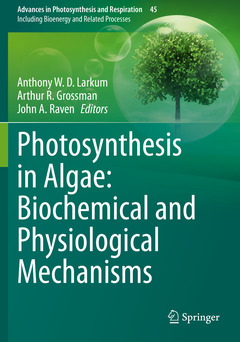Description
Photosynthesis in Algae: Biochemical and Physiological Mechanisms, 1st ed. 2020
Biochemical and Physiological Mechanisms
Advances in Photosynthesis and Respiration Series, Vol. 45
Coordinators: Larkum Anthony W.D., Grossman Arthur R., Raven John A.
Language: English
Subjects for Photosynthesis in Algae: Biochemical and Physiological...:
Keywords
photosynthesis; solar energy; biofuels; phylogenetics; evolution; algal biology
Publication date: 06-2021
Support: Print on demand
Publication date: 06-2020
514 p. · 17.8x25.4 cm · Hardback
Description
/li>Biography
/li>Comment
/li>
Algae, including cyanobacteria, are in the spotlight today for a number of reasons; firstly it has become abundantly clear over recent years that algae have been neglected in terms of basic research and that knowledge gap is being rapidly closed with the establishment of some surprising discoveries, such as the presence of Near-Infra-Red-Absorbing cyanobacteria and a wealth of natural products; secondly molecular approaches have provided a wealth of approaches to genetically modify algae and produce value-added products; thirdly it has become clear just how important, marine phytoplankton is to global carbon capture and the production of food globally; and fourthly, it has also become clear that algae present unparalleled opportunities to generate biofuels in a sustainable and non-polluting way.
This volume presents 15 chapters by world experts on their subjects, ranging from reviews of algal diversity and genetics to in-depth reviews of special algal groups such as diatoms (which account for over 30% of marine carbon capture). Other chapters chart the ways in which this carbon capture occurs or how there are a multiplicity of ways in which algae intercept sun light and deploy this energy for carbon capture. A fascinating aspect here is the way in which sun light is harvested. A special chapter is devoted to the very recent and exciting possibility that algae use coherent light energy transformation to enhance the efficiency of light capture, an aspect of quantum physics that has implications for future developments at several levels and a variety of industries. Just how and why algae use Chlorophyll a as the major light capture pigment is discussed in several chapters. However, attention is also given to those cyanobacteria, which have been found to use the special Near-Infra Red absorbing chlorophylls mentioned above. And attention is also given to those algae that employ phycobiliproteins to fill in the ?green window?, i.e., the spectral region from 400 ? 650 nm, which is not efficiently covered by chlorophyll and carotenoid pigments. Photoinhibition and photoprotection is the subject area of several chapters and one which it is essential to understand a we work towards greater efficiency of algal photosynthesis. A final chapter is devoted to understanding the molecular basis for coral bleaching, a much-neglected area that is essential in trying to come up with solutions to this very worrying phenomenon, caused by global warming and ocean acidification.
This is a book for research scientists, environmentalists, planners in a range of areas including those of marine resources, nutrient control and pollution of water bodies and that growing body of concerned citizens interested in controlling carbon emissions and global warming. Special attention has been given to generating a set of articles that will be read by university students, informed laymen and all those whose wish to understand the rapid changes that have come about in our knowledge of algae over the past decade.
Arthur Robert Grossman Arthur Grossman has been a Staff Scientist at The Carnegie Institution for Science, Department of Plant Biology since 1982, and holds a courtesy appointment as Professor in the Department of Biology at Stanford University.He has performed research across fields ranging from plant biology, microbiology, marine biology, ecology, genomics, engineering an
A unique book on photosynthesis in algae, which does not exist elsewhere
The authors are all world experts in their field
Latest fields of biofuels, bioenergy and whole genomes are dealt with in detail

